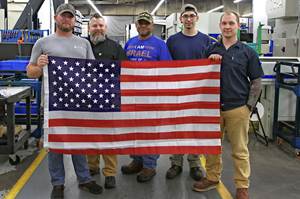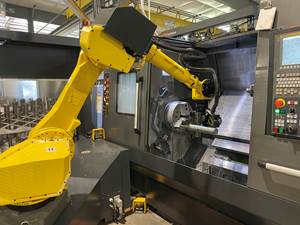Organizational Skills Cut Machine Setup Time
Many shops have embraced CNC technology and do a good job keeping their machines running by minimizing setup or changeover time. On the other hand, many companies have not mastered the art of rapid setup and suffer from too much machine downtime.
Share





Many shops have embraced CNC technology and do a good job keeping their machines running by minimizing setup or changeover time. On the other hand, many companies have not mastered the art of rapid setup and suffer from too much machine downtime.
Having been involved in numerous setup time reduction projects, as well as, conducting setup reduction training programs, I have learned that simple organization techniques will generate the biggest savings in setup time. A well-organized machine setup procedure can reduce job changeover time by 50 percent or more.
Here are a few organizational tips any company can apply to reduce setup times.
1. Prepare all paperwork, material, fixtures and tooling for the next job, while the present job is underway. Assuring that everything you need to run a job is prepared in advance is critical to reducing setup time. Each company must decide who will perform the preparation activities. This decision depends on many factors, including cycle time of present part, additional tasks being performed by the operator during the machining cycle, number of parts being run, part complexity, and so on. The most common approaches to job preparation are:
- A department setup person responsible for preparing the next job. Besides getting all required items for the next job, this person may also inspect tools and preset tool lengths, review the CNC program for accuracy and completeness, qualify the fixturing, and more.
- A "buddy system," in which teams of operators work together on setups. For example if there are two machines with two operators, one can be preparing the next job, while the other keeps an eye on both machines (loading parts, unloading parts, checking, etc.). A well-organized team of operators can keep many machines running and still handle job preparation activities.
- A department helper. This is an effective way of familiarizing new employees with machine setup and operating procedures. Although the helper may not possess all the skills necessary to perform a complete setup, this person can do the basics, such as assuring all necessary paperwork is available; getting the tools, fixtures and material; and can even assisting the operator with machine clean up.
Whichever technique is used to prepare for the next job to be run, having everything ready will significantly reduce the time a machine sits idle.
2. Store hardware and common tools in an easily accessible area. Many companies still keep hardware in coffee cans or containers and employees have to "dump and search" to find what they need. A well-organized system of storing the hardware is effective in eliminating search time, which is a major cause of most long setups. Use clearly labeled drawers for common tools and develop some type of simple reorder system to assure there is sufficient stock of critical items. Consider color coding collets and other hardware for easy recognition and access.
3. Keep frequently used tools loaded on the machines whenever possible. There are certain tools that companies use repeatedly. If the tool magazines or turrets are large enough, these tools should be kept on the machines in predetermined locations. If tools are "stored" on the machine, the operator should take responsibility to maintain these tools. Keeping frequently used tools on the machine eliminates the time-consuming steps of loading and unloading tools.
4. Develop a standard setup procedure. All employees should follow the same sequence of operations when setting up a machine. A setup checklist should be developed for each machine and kept close to the machine. Consistency in setup procedures leads to consistency in setup times.
5. Make sure everyone practices proper housekeeping. Housekeeping in a shop means maintaining a clean and orderly workplace. This involves treating all items carefully and returning them to their proper storage area when no longer needed. "A place for everything, and everything in its place." Cleaning up spills as they occur and frequently removing chips from the machine keeps cleanup manageable.
There are many other techniques for reducing setup times, but those require capital. The simple techniques described above require little or no cost and can help anyone get organized for better and faster machine setups.
Related Content
Finding Skilled Labor Through Partnerships and Benefits
To combat the skilled labor shortage, this Top Shops honoree turned to partnerships and unique benefits to attract talented workers.
Read MoreSame Headcount, Double the Sales: Successful Job Shop Automation
Doubling sales requires more than just robots. Pro Products’ staff works in tandem with robots, performing inspection and other value-added activities.
Read MoreDN Solutions Responds to Labor Shortages, Reshoring, the Automotive Industry and More
At its first in-person DIMF since 2019, DN Solutions showcased a range of new technologies, from automation to machine tools to software. President WJ Kim explains how these products are responses to changes within the company and the manufacturing industry as a whole.
Read MoreHow I Made It: Nushrat Ahmed: CNC Swiss Operator
By day, 21-year-old Nushrat Ahmed is a CNC Swiss operator making automotive parts. By night, she handcrafts crocheted items.
Read MoreRead Next
Machine Shop MBA
Making Chips and Modern Machine Shop are teaming up for a new podcast series called Machine Shop MBA—designed to help manufacturers measure their success against the industry’s best. Through the lens of the Top Shops benchmarking program, the series explores the KPIs that set high-performing shops apart, from machine utilization and first-pass yield to employee engagement and revenue per employee.
Read MoreAMRs Are Moving Into Manufacturing: 4 Considerations for Implementation
AMRs can provide a flexible, easy-to-use automation platform so long as manufacturers choose a suitable task and prepare their facilities.
Read More



















